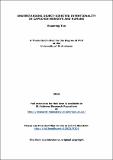Files in this item
Understanding object-directed intentionality in Capuchin monkeys and humans
Item metadata
| dc.contributor.advisor | Gomez, Juan-Carlos | |
| dc.contributor.advisor | Seed, Amanda Madeleine | |
| dc.contributor.author | Tao, Ruoting | |
| dc.coverage.spatial | vi, 244 p. | en_US |
| dc.date.accessioned | 2016-08-15T14:44:48Z | |
| dc.date.available | 2016-08-15T14:44:48Z | |
| dc.date.issued | 2016-06 | |
| dc.identifier | uk.bl.ethos.693133 | |
| dc.identifier.uri | https://hdl.handle.net/10023/9304 | |
| dc.description.abstract | Understanding intentionality, i.e. coding the object directedness of agents towards objects, is a fundamental component of Theory of Mind abilities. Yet it is unclear how it is perceived and coded in different species. In this thesis, we present a series of comparative studies to explore human adults’ and Capuchin monkeys’ ability to infer intentional objects from actions. First we studied whether capuchin monkeys and adult humans infer a potential object from observing an object-directed action. With no direct information about the goal-object, neither species inferred the object from the action. However, when the object was revealed, the monkeys retrospectively encoded the directedness of the object-directed action; unexpectedly, in an adapted version of the task adult humans did not show a similar ability. We then adapted another paradigm, originally designed by Kovács et al (2010), to examine whether the two species implicitly register the intentional relation between an agent and an object. We manipulated an animated agent and the participants’ belief about a ball’s presence behind a hiding screen. We found no evidence showing that humans or monkeys coded object-directedness or belief. More importantly, we failed to replicate the original results from Kovács et al’s study, and through a series of follow up studies, we questioned their conclusions regarding implicit ToM understanding. We suggested that, instead of implicit ToM, results like Kovacs et al’s might be interpreted as driven by “sub-mentalizing” processes, as suggested by Heyes (2014). We conclude that so called ‘implicit ToM’ may be based upon the computation of intentional relations between perceived agents and objects. But, these computations might present limitations, and some results attributed to implicit ToM may in fact reflect “sub-mentalizing” processes. | en_US |
| dc.language.iso | en | en_US |
| dc.publisher | University of St Andrews | |
| dc.subject | Intentionality | en_US |
| dc.subject | Object-directedness | en_US |
| dc.subject | Implicit ToM | en_US |
| dc.subject | Belief | en_US |
| dc.subject | Theory of mind | en_US |
| dc.subject | Primate | en_US |
| dc.subject.lcc | QL785.T2 | |
| dc.subject.lcsh | Cognition in animals | en_US |
| dc.subject.lcsh | Capuchin monkeys--Psychology | en_US |
| dc.subject.lcsh | Cognition | en_US |
| dc.subject.lcsh | Philosophy of mind | en_US |
| dc.title | Understanding object-directed intentionality in Capuchin monkeys and humans | en_US |
| dc.type | Thesis | en_US |
| dc.type.qualificationlevel | Doctoral | en_US |
| dc.type.qualificationname | PhD Doctor of Philosophy | en_US |
| dc.publisher.institution | The University of St Andrews | en_US |
This item appears in the following Collection(s)
Items in the St Andrews Research Repository are protected by copyright, with all rights reserved, unless otherwise indicated.

